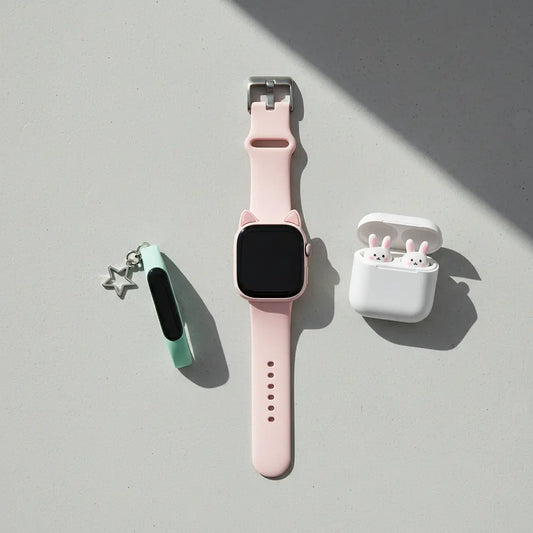
How Do Twitching Cat Ear Headbands Work?
How Do Twitching Cat Ear Headbands Work?
You see them across the convention floor—a pair of cat ears on a cosplayer’s head. Then, something incredible happens. As their friend tells a joke, the ears perk up. When they look down, feeling shy, the ears droop slightly. It feels like magic, a piece of an anime world brought to life. But is it real?
Many people see these moving cat ears for anime fans and feel a mix of fascination and skepticism. Are they just a gimmick, moving randomly to create an illusion? Or is there genuine technology at play? This article pulls back the curtain. We will explain exactly how do twitching ears headbands work, demystifying the science in a simple, clear way.
Quick Poll: Would you wear brainwave cat ears?
What Are Twitching Cat Ear Headbands?
Ever seen those iconic moving ears and wondered what they actually are? This section defines these popular gadgets and traces their origins from a clever invention to a cosplay staple.
Twitching cat ear headbands are wearable electronic accessories designed to mimic the ear movements of an animal, primarily a cat. Unlike static ears attached to a simple band, these contain sensors and motors. This allows them to physically react, creating an interactive and expressive experience for the wearer and those around them.
The concept was popularized and brought into the mainstream by the brand Neurowear with their Nekomimi brainwave ears. First debuting at conventions, they captured the imagination of the anime and cosplay community. They weren't just a costume piece; they were an experience, promising to reflect the wearer's emotional state through movement. This innovation turned a simple accessory into a piece of wearable anime gadgets.
Today, these headbands are a common sight at events like Comic-Con and local anime meetups. Top cosplay influencers often feature them, showcasing how the ears react during unboxings or gameplay streams. This visibility has cemented their status as a must-have accessory for anyone looking to add an interactive, high-tech flair to their costume.
The Science Behind Emotional Sensor Ears
Does the idea of a headband reading your mood sound like science fiction? Let's break down the core technology, showing how simple sensors can translate your brain's subtle signals into visible, physical motion.
The "magic" behind emotional sensor cat ears explained is a technology called electroencephalography, or EEG. While that sounds complex, the concept is simple. Your brain produces tiny, constant electrical pulses, often called brainwaves. The patterns of these waves change depending on your mental and emotional state—for example, when you are focused, relaxed, or excited.
The headband has a small, dry sensor that rests on your forehead. Think of this sensor not as a mind-reader, but as a sensitive microphone listening for the overall "volume" and "tempo" of your brain's activity. It doesn't know *what* you're thinking, but it can detect shifts between states of high concentration and states of relaxation or "zoning out."
For instance, when you are deeply engaged in a conversation or solving a problem, your brain produces faster "beta" waves. When you relax and let your mind wander, it shifts to slower "alpha" waves. The headset’s internal chip is programmed to associate these general patterns with different emotional states, providing the trigger for the next step: movement.
How Do Twitching Ear Headbands Actually Move?
So, the headband detects a change in your mood. But how does that signal make the ears physically perk up or droop? We’ll now look under the hood at the tiny mechanics that bring these ears to life.
Once the brainwave sensor detects a shift in your emotional state, it sends a signal to a small micro-controller inside the headband. This chip acts as the translator, converting the electrical brainwave data into a specific command. That command is then sent to the real stars of the show: the servo motors.
A servo motor is a tiny, precise motor located at the base of each ear. Unlike a simple motor that just spins, a servo can be told to move to a specific angle and hold it. Think of it like the joints in your fingers, which can bend to precise positions. This is what allows for nuanced and lifelike movements.
The controller sends different commands based on the brainwave input, resulting in distinct ear patterns. This signal-to-movement process is what creates the expressive quality of the ears.
- Perking Up: Often triggered by a state of high focus or engagement (beta waves). The servos rotate upward quickly, mimicking an alert or curious cat.
- Drooping: This is typically linked to a relaxed or passive state (alpha waves). The servos slowly lower the ears, suggesting calmness or tiredness.
- Wiggling/Twitching: Some models include a "wiggle" or "twitch" pattern that can indicate a mixed state or serve as a neutral, "active" mode.
A common misconception is that the ears have dozens of movements. In reality, most models rely on these 2-3 core positions. The "lifelike" feeling comes from the speed and timing of the transitions between them, which are directly tied to your brain's real-time activity.
Do They Really Work or Is It Just a Gimmick?
Are you still a bit skeptical? It’s a fair question. This section directly addresses the doubt, weighing the scientific credibility against the fun factor to determine if these headbands are the real deal.
This is the most common question, and the answer is: Yes, they work, but maybe not how you think. The skepticism is valid. Consumer-grade brainwave sensors in a Nekomimi brainwave headband are not as powerful as the multi-sensor caps used in medical research. They are not reading your specific thoughts or complex emotions like "jealousy" or "nostalgia."
Instead, they excel at detecting broad shifts in mental states. The most reliable distinction they make is between active concentration and passive relaxation. Users consistently report that the ears perk up when they focus on a game or a friend telling a story, and droop when they zone out or feel calm. The technology is legitimate, but its application is for entertainment.
Countless user testimonials and video reactions confirm this. A quick search will show you videos of users exclaiming in surprise as the ears twitch right when they get excited. One Amazon reviewer might note, "I thought it was random at first, but it perks up every single time my cat jumps on my lap." This consistent user experience is the strongest evidence against the "gimmick" theory.
Ultimately, these interactive cat ear headbands are a blend of real science and novelty fun. While they won't give you a deep diagnostic of your emotional health, they are genuinely responsive. They succeed because they create a believable and delightful connection between your inner state and an external expression.
Best Twitching Ear Headbands for Cosplay (2025 Edition)
Feeling convinced and ready to find your own pair, but not sure where to start? We'll navigate the current market, highlighting the top brands and what makes each one stand out for cosplay enthusiasts.
Choosing the best twitching ears headband for cosplay depends on your priorities: realism, sensor sensitivity, or budget. The market for cosplay headbands with moving ears has grown, offering several great options. Based on community feedback and feature sets, here are the top contenders for 2025.
| Model | Best For | Key Feature |
|---|---|---|
| Neurowear Prime 2 | The Original Experience & Sensitivity | Most refined brainwave sensors and durable build. High-end price for brand trust. |
| Cosplay-Tronics Aura V3 | Realism and Customization | Ultra-realistic faux fur and a companion app for sensitivity adjustments. |
| Kawa-Kitsune Gen-S | Budget-Friendly Entry | Delivers core interactive features at a more accessible price point. |
For a more comprehensive look at these options, our guides break down the technology in detail. To understand the foundational science of how these accessories function, the go-to resource is our article, "From Cute to Clever: What Are Moving Cat Ears?", which offers a great starting point for any curious cosplayer. To explore our full collection of interactive gear and see how the latest 2025 models perform, check out our guide on How Twitching Cat Ear Headbands Work in 2025.
How to Style and Use Nekomimi Cat Ears
You’ve got the perfect pair of moving ears. Now what? Let's cover the pro tips for integrating them flawlessly into your cosplay, wearing them comfortably all day, and keeping them in perfect working order.
Getting the most out of your Nekomimi brainwave ears goes beyond just putting them on. Proper styling and care ensure they look amazing and function correctly, especially during a long convention day.
Integrating into Your Cosplay
The biggest challenge is often hiding the headband. The best method is to wear the headband first and then put your wig on over it. Gently pull the wig hair apart where the ears will emerge. You can also use matching hair clips to secure the wig fibers around the base of the ears for a seamless, natural look.
All-Day Convention Comfort
Make sure the forehead sensor has clean, direct contact with your skin. Avoid placing it over makeup or "wig glue," as this can interfere with readings. Before a long day, wear the headband for an hour at home to ensure the pressure is comfortable. If it feels too tight, add a small piece of foam padding to the sides.
Maintenance and Storage Pro-Tips
- Cleaning: Never submerge the ears in water. To clean the fur, use a small amount of dry shampoo or a slightly damp cloth, being careful to avoid the mechanical base.
- Sensor Care: Gently wipe the forehead sensor with a soft, dry cloth after each use to remove skin oils, which can degrade its sensitivity over time.
- Storage: Store the headband in its original box or a hard case. This protects the delicate servo motors from getting crushed in a bag, which is the most common cause of damage.
The Future of Interactive Cosplay Gadgets
Think twitching ears are impressive? That's just the beginning. Let’s look ahead at the exciting future of wearable tech and how it’s set to make cosplay more interactive and immersive than ever before.
The technology powering brainwave cosplay accessories is the gateway to a whole new level of interactive performance art. Twitching ears walked so that fully responsive costumes could run. We are already seeing the next wave of innovation, moving beyond simple emotional feedback to environmental and user-driven interactions.
One of the biggest trends is the integration of programmable LEDs and sound sensors. Imagine a wizard costume where the staff's crystal pulses with light that matches the rhythm of ambient music, or a sci-fi armor set where panels glow brighter as the convention hall gets louder. These are no longer just concepts; they are being built by creators right now.
For those who love to tinker, the DIY community is where the most exciting experiments happen. Using platforms like Arduino and Raspberry Pi, creators are building their own custom cosplay tech accessories. If you're inspired to build your own expressive gear from scratch, the perfect next step is our comprehensive "DIY Moving Cat Ears: Arduino Cosplay Guide," which walks you through the entire process from circuits to code. This hands-on approach is pushing the boundaries of what's possible.
While ears are a fantastic starting point, the world of animated accessories is expanding. Many cosplayers are now pairing their moving ears with other dynamic elements. To see how these trends are evolving beyond headwear, explore our deep-dive on why cosplay fox tails are trending from convention halls to everyday fashion.
Looking ahead to 2025 and beyond, expect to see more integration with Augmented Reality (AR). A future cosplay could include glasses that project a digital familiar onto your shoulder, visible to anyone with a smartphone, or gauntlets that trigger special effects on a screen when you make a certain gesture. The costume is becoming the controller.
Which Cosplay Style Fits You Best?
Conclusion
From a mysterious convention novelty to a beloved piece of cosplay tech, twitching cat ear headbands have proven they are far more than a simple gimmick. We've seen that their movement isn't random magic, but the result of accessible brainwave science, clever sensors, and precise motors working together. They are a perfect fusion of playful expression and genuine innovation.
These gadgets represent a desire not just to look like a character, but to feel and interact like one. As technology continues to advance, the line between costume and experience will only get more exciting. Your cosplay is no longer static—it's alive.
Ready to explore more amazing cosplay tech?
Browse our complete guides Subscribe for the latest innovations Follow us on social mediaFAQ: Everything You Wanted to Know About Brainwave Cat Ears
1. How long do the batteries last in brainwave cat ears?
Most models use AAA batteries and provide between 4 to 8 hours of continuous use, depending on how active the motors are. For a full convention day, it's a smart idea to bring a spare set of batteries just in case. Some newer premium models are introducing rechargeable USB-C options.
2. Can I wear moving cat ears with a wig?
Absolutely! This is the most common way to wear them. For the best look, place the headband on your head first, then carefully style your wig over and around it. Secure the wig fibers around the base of the ears to create a seamless blend. The key is ensuring the forehead sensor still makes direct contact with your skin.
3. Are emotional sensor headbands heavy or uncomfortable?
They are designed to be lightweight, typically weighing only slightly more than a standard pair of audio headphones. Most users find them comfortable for several hours. However, if you're sensitive to pressure, you might want to take a short break every couple of hours during a long event.
4. Where is the best place to buy affordable twitching ears for cosplay?
For the most affordable twitching ears cosplay headbands, online marketplaces like Amazon and AliExpress are popular starting points. You can often find budget-friendly models there. For higher quality and better support, dedicated cosplay shops and the official brand websites (like Neurowear's) are the recommended places to buy moving cat ears online.




